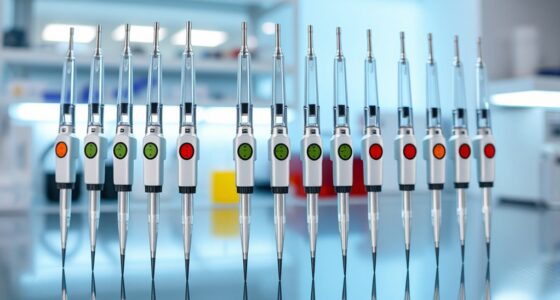If you’re looking for the best vacuum desiccators to control moisture in your lab, I recommend considering models like the SP Bel-Art Space Saver, F42400-4001, and United Scientific options, which offer durability, clear visibility, and reliable vacuum performance. Factors such as size, material, and sealing features matter for your specific needs. To discover the top choices tailored for your setup, exploring the options further can be really helpful.
Key Takeaways
- Look for models with high vacuum retention capabilities, such as maintaining over 72 hours or 100 days, for reliable moisture control.
- Choose desiccators made from impact-resistant, chemical-resistant materials like polycarbonate or borosilicate glass for durability and visibility.
- Opt for models with integrated vacuum gauges, dual valves, and airtight seals to ensure precise pressure monitoring and maintenance.
- Select designs with large, ribbed knobs and transparent lids for easy handling, quick inspection, and efficient workflow.
- Consider space-saving flat dome or cubic models offering maximum interior volume and easy access for effective moisture management.
Dyson V15 Detect Plus Cordless Vacuum, Yellow/Nickel
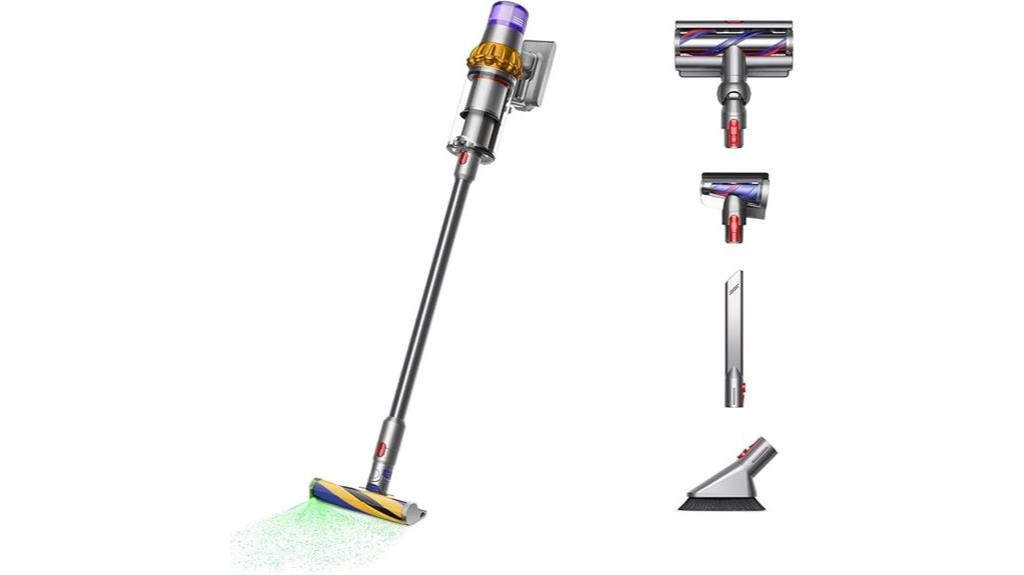
If you’re looking for a versatile cordless vacuum that handles all your cleaning needs with ease, the Dyson V15 Detect Plus in Yellow/Nickel is an excellent choice. It comes with two advanced cleaner heads and four attachments, making it perfect for high, low, and hard-to-reach spots. The Fluffy Optic cleaner head reveals invisible dust on hard floors, while the Digital Motorbar head tackles deep cleaning and pet hair. With a power trigger that maximizes efficiency and up to 60 minutes of runtime, this lightweight vacuum adapts to different floor types and debris, ensuring thorough, whole-home cleaning with ease.
Best For: homeowners and pet owners seeking a versatile, powerful cordless vacuum for whole-home cleaning with intelligent features and deep cleaning capabilities.
Pros:
- Includes multiple cleaner heads and attachments for versatile cleaning on various surfaces and hard-to-reach spots
- LCD screen displays detailed cleaning data and maintenance alerts for convenience and efficiency
- Up to 60 minutes of runtime and lightweight design for easy maneuverability and thorough cleaning
Cons:
- Higher price point compared to basic cordless vacuums
- May require frequent maintenance or filter cleaning due to advanced technology
- Battery life can vary depending on power mode and usage, potentially limiting cleaning sessions
ProTeam Backpack Vacuums, ProVac FS 6 Commercial Backpack Vacuum
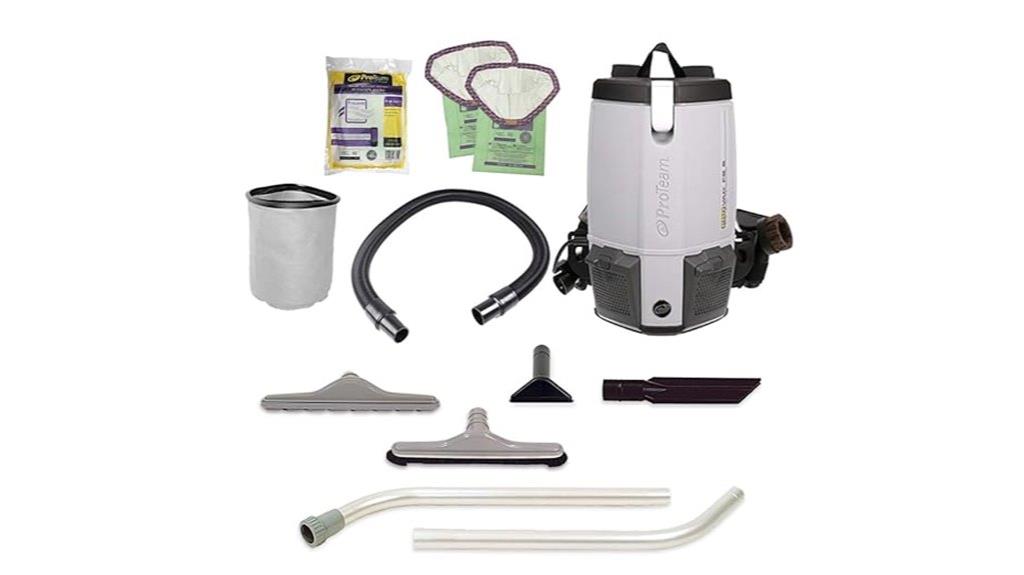
The ProTeam ProVac FS 6 Commercial Backpack Vacuum stands out for its powerful performance and advanced filtration, making it an excellent choice for cleaning professionals who require efficiency and air quality. With a 6-quart capacity and versatile accessories, it handles tough messes on hard floors, carpets, and around furniture. Its four-level filtration, including a HEPA Media Filter, captures 99.97% of particles 0.3 microns and larger, ensuring cleaner indoor air. The adjustable harness and open-weave fabric keep users comfortable during extended use. Plus, with a 50-foot cord, it easily covers large areas without frequent unplugging, boosting productivity and convenience.
Best For: cleaning professionals and commercial facilities seeking efficient, high-quality vacuuming with excellent air filtration and comfort during extended use.
Pros:
- Powerful performance with a 6-quart capacity suitable for tough messes
- Advanced four-level filtration including HEPA Media Filter capturing 99.97% of particles 0.3 microns and larger
- Comfortable adjustable harness and open-weave fabric for extended use without fatigue
Cons:
- Slightly noisy at 69.7 dBA, which may be disruptive in quiet environments
- Heavier weight typical of backpack vacuums could cause fatigue over long periods
- Higher price point compared to basic models, reflecting its professional features
SP Bel-Art Space Saver Vacuum Desiccator with Clear Polycarbonate Bottom
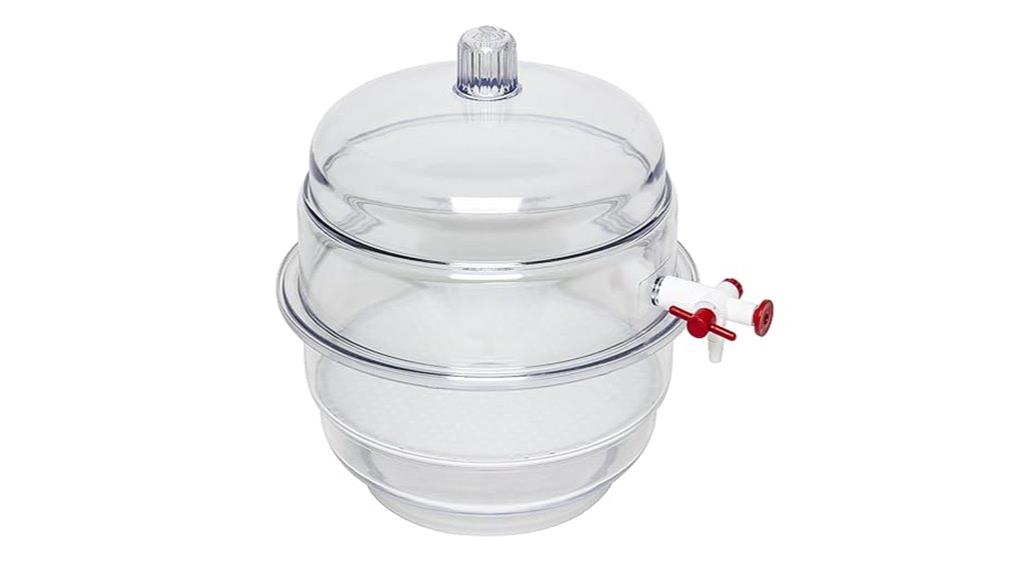
For laboratory professionals seeking a compact, durable vacuum desiccator, the SP Bel-Art Space Saver with a clear polycarbonate bottom stands out. Its 0.31 cu. ft. capacity offers more interior volume than standard models, thanks to a flat dome lid with a large ribbed knob for easy handling. It maintains a full vacuum for 24 hours at room temperature, ensuring reliable moisture control. Made from chemical-resistant polycarbonate, it’s tough and clear for easy monitoring. The included polypropylene stopcock with PTFE plug allows precise air control, while the perforated plate accommodates desiccants. Overall, it’s a space-efficient, dependable choice for sensitive laboratory applications.
Best For: laboratory professionals needing a reliable, space-saving vacuum desiccator for moisture-sensitive materials and drying processes.
Pros:
- Holds a full vacuum for 24 hours at room temperature, ensuring consistent airtight conditions
- Made from durable, chemical-resistant polycarbonate for clear visibility and long-lasting use
- Flat dome lid with large ribbed knob provides easy handling and approximately 13% more interior volume than standard models
Cons:
- Limited capacity of 0.31 cu. ft., which may not accommodate larger items or bulk samples
- Requires a separate vacuum pump or source to establish the full vacuum initially
- Polycarbonate construction, while durable, can be susceptible to scratching or cracking over extended use with certain chemicals
SP Bel-Art Lab Companion Vacuum Desiccator (F42400-4001)
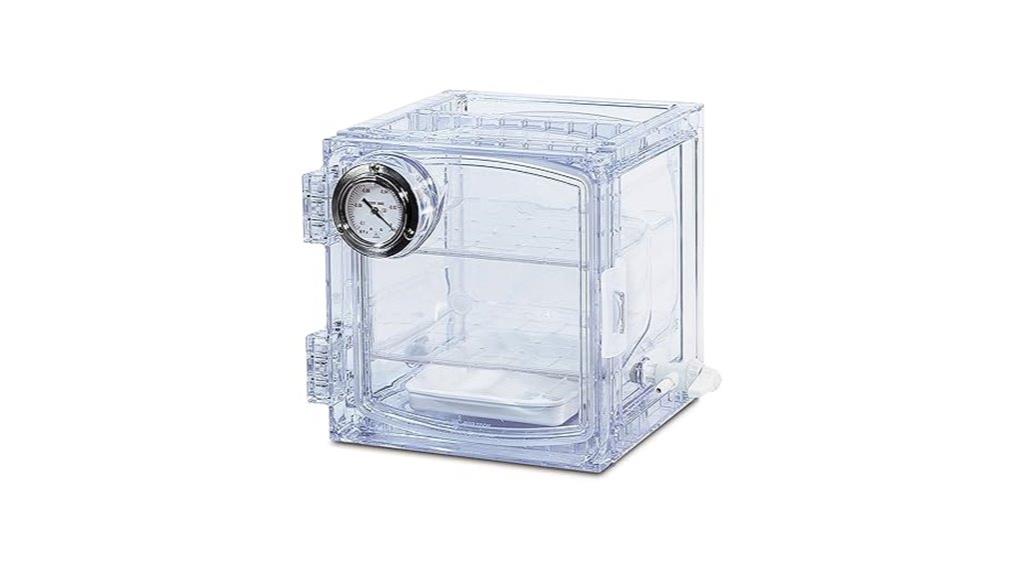
The SP Bel-Art Lab Companion Vacuum Desiccator (F42400-4001) stands out as an excellent choice for professionals who need reliable, long-lasting vacuum storage. Its integrally molded cubic design ensures outstanding vacuum capability, minimal leakage, and durability. The cabinet style maximizes space, while the swinging door provides easy access. Made from chemical-resistant polycarbonate, it’s easy to clean and offers quick content visualization. The built-in locking tabs secure the door, and the vacuum gauge allows for quick level checks. With a vacuum that lasts over 72 hours, it’s perfect for long-term storage, experiments, and gas exchange needs.
Best For: research, industrial, and healthcare professionals seeking reliable long-term vacuum storage for samples, experiments, and gas exchange processes.
Pros:
- Integrally molded cubic design provides outstanding vacuum capability and minimal leakage
- Durable, chemical-resistant polycarbonate construction allows easy cleaning and quick content visualization
- Vacuum lasts over 72 hours, ensuring reliable long-term storage and experiments
Cons:
- May be more expensive than simpler desiccator models
- Limited to 11L capacity, which might not suit larger storage needs
- Requires careful handling of the locking tabs and vacuum gauge to maintain optimal performance
SP Bel-Art Space Saver Polycarbonate Vacuum Desiccator with White Polypropylene Bottom
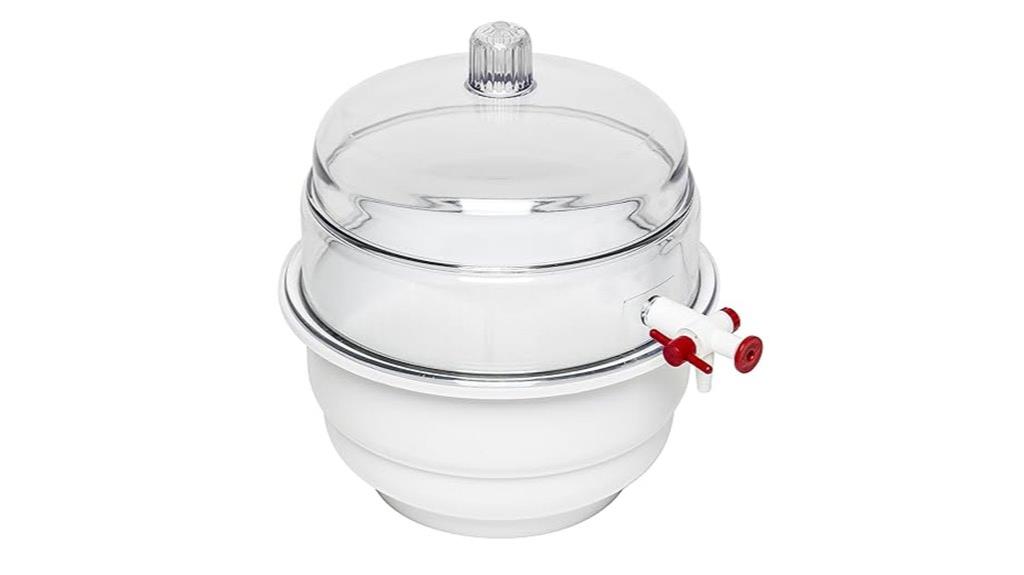
If you’re seeking a reliable desiccator that maximizes interior space without sacrificing airtight performance, the SP Bel-Art Space Saver Polycarbonate Vacuum Desiccator is an excellent choice. Its ‘Flat Dome’ design provides about 13% more usable space than standard models, making it ideal for larger samples. Capable of holding a full vacuum of 29.9 Hg for 24 hours, it ensures consistent protection. Made with a clear polycarbonate top and either a clear polycarbonate or white polypropylene bottom, it’s durable and chemical-resistant. The large ribbed knob allows easy handling, while the polypropylene stopcock with PTFE plug offers precise air control during vacuum and venting.
Best For: researchers and laboratory professionals needing a durable, space-efficient vacuum desiccator with excellent airtight performance for large or multiple samples.
Pros:
- Maximizes interior space with ‘Flat Dome’ design, providing approximately 13% more volume than standard models.
- Capable of holding a full vacuum of 29.9 Hg for 24 hours, ensuring reliable airtight protection.
- Made from durable, chemical-resistant materials including clear polycarbonate and white polypropylene, with an easy-to-handle large ribbed knob.
Cons:
- The perforated plate may require replacement if damaged or if specific desiccant placement is needed.
- The stopcock with PTFE plug may require maintenance or replacement over time to maintain optimal air control.
- The size and capacity (0.20 cu. ft.) may not be suitable for very small or very large sample requirements.
Thickened PC Vacuum Desiccator with Stopcock and O-Ring
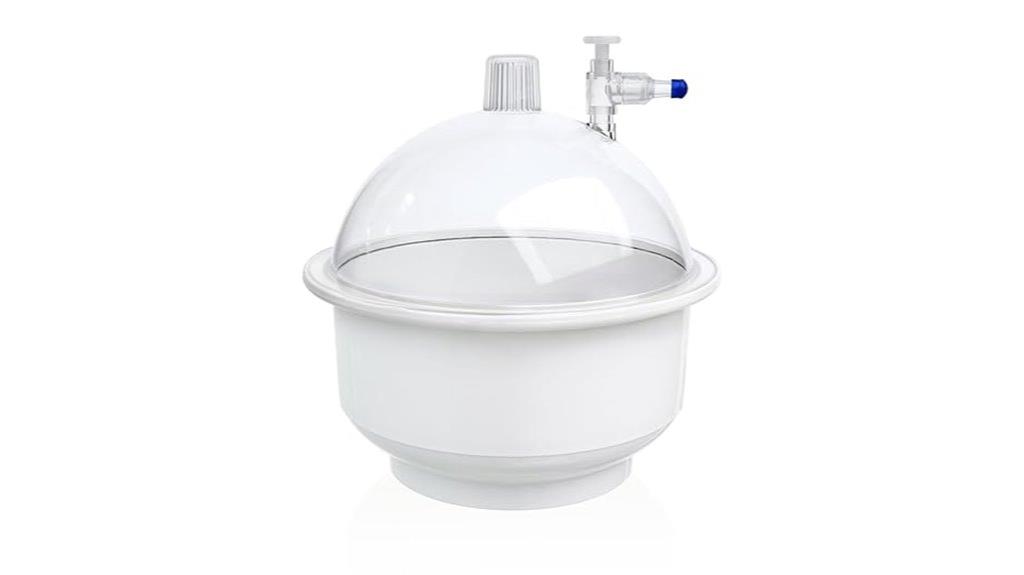
When choosing a vacuum desiccator for sensitive applications, the Thickened PC Vacuum Desiccator with Stopcock and O-Ring stands out due to its durable impact-resistant polycarbonate cover. Its high-transparency material allows easy internal observation, making it convenient for monitoring contents. The silicone rubber O-ring provides a reliable vacuum seal without needing sealing grease, ensuring consistent performance. The perforated plate, made from PP, is versatile for both disposable and reusable desiccants. With a diameter of 150mm and height of 160mm, it’s ideal for protecting hygroscopic chemicals, biochemical reagents, and precision instruments, prolonging their preservation with efficient moisture control.
Best For: Researchers and professionals needing reliable, transparent vacuum storage for hygroscopic or sensitive materials in laboratory settings.
Pros:
- Durable impact-resistant polycarbonate cover for long-lasting use
- High-transparency design allows easy internal observation of contents
- Reliable vacuum sealing with silicone rubber O-ring eliminates the need for sealing grease
Cons:
- Limited to items that fit within 150mm diameter and 160mm height dimensions
- Perforated PP plate may require replacement or cleaning for reusable desiccants
- Not suitable for very high vacuum applications beyond its designed capacity
150mm/250mm Laboratory Vacuum Desiccator with Double Valve and Pressure Gauge
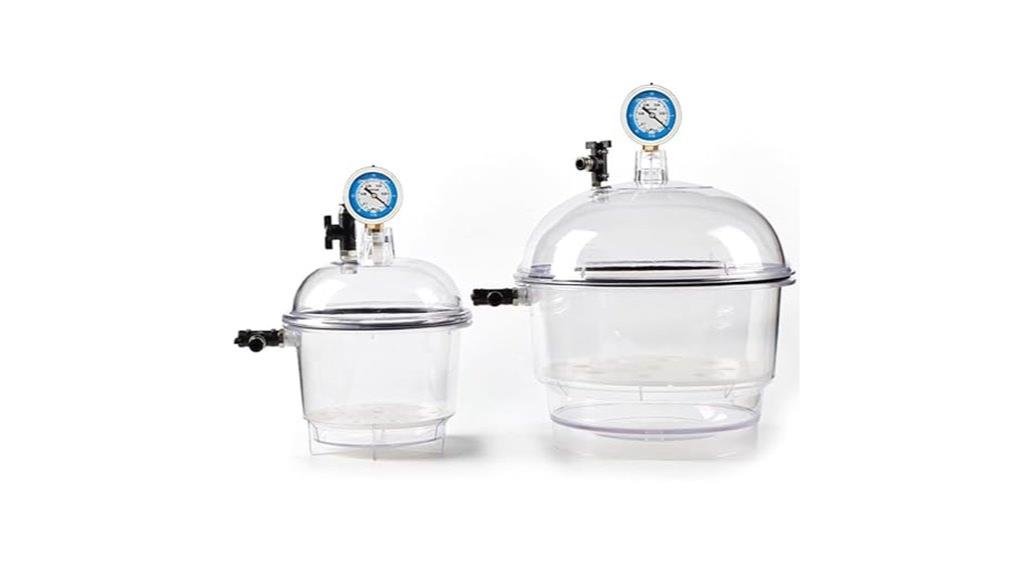
A 150mm/250mm laboratory vacuum desiccator with double valves and a pressure gauge offers precise control and reliable sealing, making it ideal for professionals handling sensitive materials. Its high-quality polycarbonate construction guarantees durability and chemical resistance, perfect for vacuum drying and storage. The double valves allow simultaneous vacuuming and inert gas introduction, while the pressure gauge provides real-time monitoring. Quick-change connectors and adjustable needle valves make operation flexible and safe. Designed for long vacuum retention with minimal leakage, it’s suitable for storing biochemical reagents, optical lenses, and volatile liquids. Proper maintenance and careful handling help maximize its performance and lifespan in your lab.
Best For: professionals and researchers who require reliable, chemical-resistant vacuum drying and storage solutions for sensitive laboratory materials.
Pros:
- Made from durable, chemical-resistant high-quality polycarbonate for long-term use.
- Equipped with double valves and a pressure gauge for precise control and real-time monitoring.
- Supports simultaneous vacuuming and inert gas introduction, enhancing versatility and safety.
Cons:
- Not suitable for high-pressure sterilization or exposure to aggressive organic solvents.
- Requires careful sealing and maintenance to prevent leaks and ensure optimal performance.
- Handling and installation of valves and sealants necessitate proper tools and expertise.
United Scientific® Borosilicate Glass Desiccator, 12 (300mm), 1each
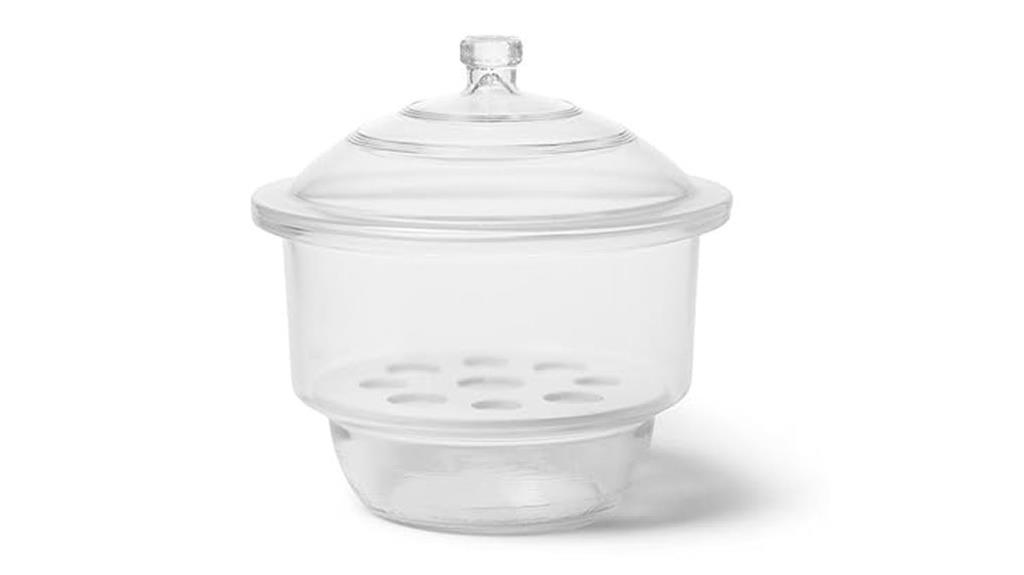
The United Scientific® Borosilicate Glass Desiccator, 12-inch (300mm), stands out as an excellent choice for laboratories requiring durable and clear storage. Made from high-quality borosilicate glass, it offers excellent visibility and strength. The matching lid with a molded-in knob makes handling easy, and the ground glass rims ensure a tight seal once greased. The perforated porcelain plate allows for even drying of samples or desiccants like silica gel. It’s suitable for non-vacuum applications and can be autoclaved for sterilization. This desiccator’s transparency helps me easily monitor moisture levels and desiccant effectiveness.
Best For: laboratory professionals and researchers needing a durable, clear, and reliable storage solution for drying agents and moisture-sensitive samples.
Pros:
- Made from high-quality borosilicate glass for durability and excellent visibility.
- Features a ground glass rim with a molded-in knob for easy handling and a tight, airtight seal when greased.
- Suitable for autoclaving, allowing sterilization without compromising integrity.
Cons:
- Requires greasing of rims before sealing to ensure airtightness.
- Not designed for vacuum applications, limiting its use in certain experimental setups.
- Glass construction may be fragile if mishandled or dropped.
Thickened PC Vacuum Desiccator (Dia.150mm)

Designed for users who require reliable vacuum sealing and clear internal visibility, the Thickened PC Vacuum Desiccator (Dia.150mm) features a high-impact, transparent polycarbonate cover that allows easy observation of stored items. Its impact-resistant material guarantees durability during handling, while the 150mm diameter and 160mm height provide ample space for small to medium-sized samples. The silicone rubber O-ring guarantees a secure vacuum seal without the need for sealing grease, supporting efficient drying and storage. The perforated PP plate can be reused or replaced with disposable desiccants, making this desiccator versatile for protecting hygroscopic or water-sensitive materials.
Best For: researchers and laboratory professionals needing reliable vacuum sealing and clear visibility for small to medium-sized samples.
Pros:
- Durable impact-resistant polycarbonate cover for long-term use
- Transparent design allows easy observation of contents without opening
- Reusable or disposable perforated plate offers flexible desiccant options
Cons:
- Limited to items fitting within 150mm diameter and 160mm height
- Requires careful handling to maintain vacuum integrity
- Not suitable for large-scale or industrial applications
United Scientific Polycarbonate Vacuum Desiccator (6)
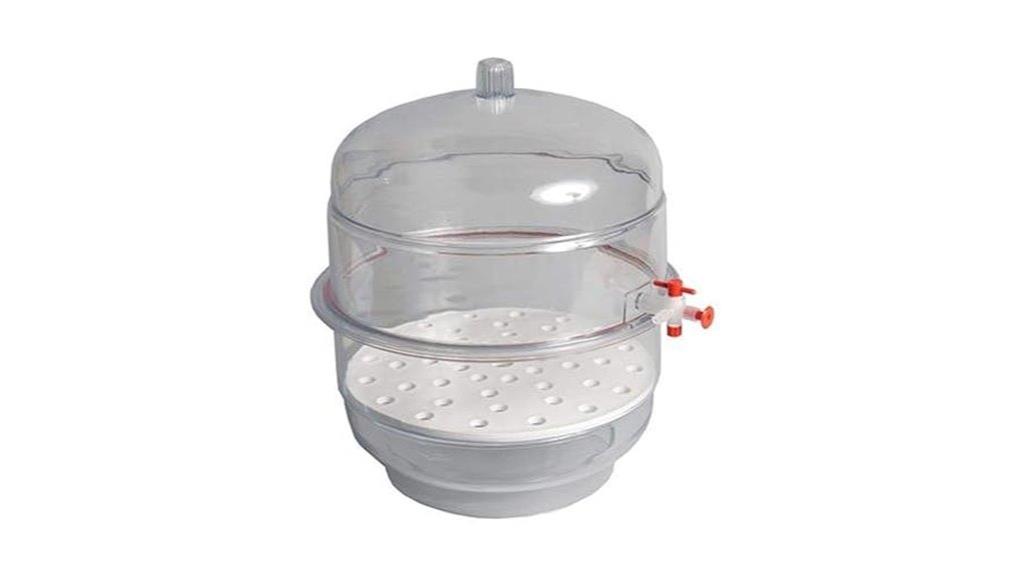
If you’re searching for a durable vacuum desiccator that offers crystal-clear visibility, the United Scientific Polycarbonate Vacuum Desiccator stands out. Made from polypropylene and polycarbonate, it’s autoclavable at 120°C for 15 minutes, ensuring easy sterilization. Its transparent PC dome and bottom allow you to monitor samples without opening the unit. The internal flange groove securely holds the silicon rubber O-ring for a reliable seal, while the perforated PP plate promotes airflow. With a vacuum capacity up to 740mm Hg and a 24-hour hold time, it’s perfect for long-term moisture control. The knurled knob and three-way stopcock make operation straightforward and secure.
Best For: Researchers and laboratory professionals seeking a durable, sterilizable vacuum desiccator with clear visibility and reliable sealing for long-term moisture control.
Pros:
- Autoclavable at 120°C for easy sterilization and reuse.
- Transparent polycarbonate dome and bottom for unobstructed sample monitoring.
- Secure sealing with internal flange groove and silicon rubber O-ring ensures vacuum integrity.
Cons:
- Limited to a vacuum of 740mm Hg, which may not suit ultra-high vacuum applications.
- Made primarily of polypropylene and polycarbonate, which may be less resistant to certain chemicals.
- Requires careful handling of the stopcock and gasket to maintain a proper seal over time.
SP Bel-Art Space Saver Desiccator (F42030-0000)
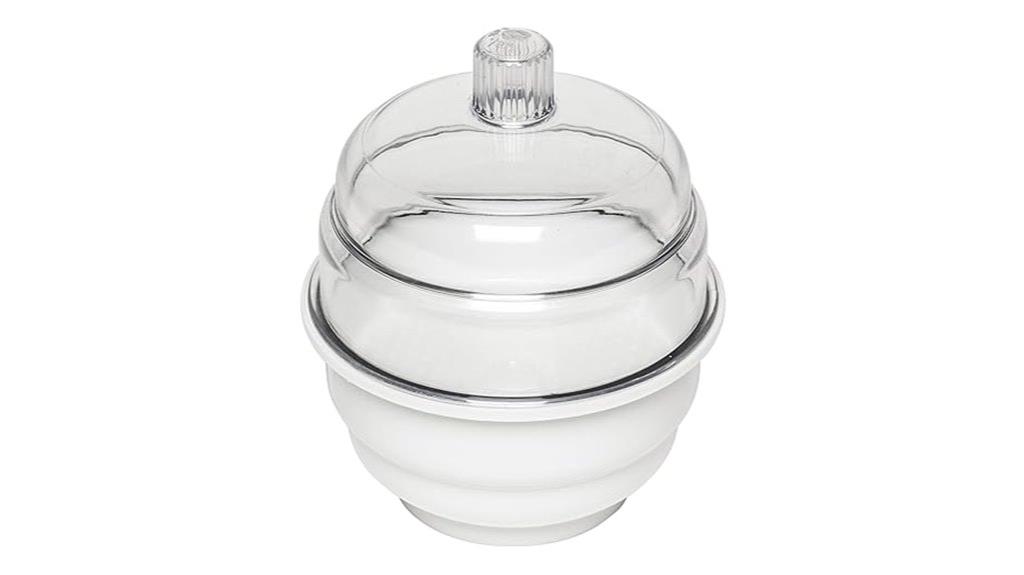
For those seeking a reliable, compact desiccator with excellent visibility and chemical resistance, the SP Bel-Art Space Saver Desiccator (F42030-0000) stands out. Its polycarbonate top provides a clear view of samples, while the white polypropylene base resists chemicals. With a 0.09 cu. ft. capacity, it offers 13% more volume than typical models, optimizing space. The removable perforated support plate allows easy insertion of desiccants and supports hot crucibles if needed. Although maintaining an airtight seal can be challenging, its durable construction and easy access make it a practical choice for moisture-sensitive samples in busy labs.
Best For: laboratories or research facilities needing a compact, durable, and transparent desiccator for humidity-sensitive samples and chemical resistance.
Pros:
- Clear polycarbonate top allows unobstructed viewing of samples.
- Compact design maximizes interior volume while saving space.
- Chemical-resistant polypropylene base suitable for various laboratory conditions.
Cons:
- Maintaining an airtight seal can be difficult and may require frequent adjustments.
- Neoprene O-ring might be prone to dislodgement or size issues.
- Some users report needing large amounts of Vaseline to improve sealing effectiveness.
Generic Vacuum Desiccators, Small Laboratory Transparent Plastic Desiccator
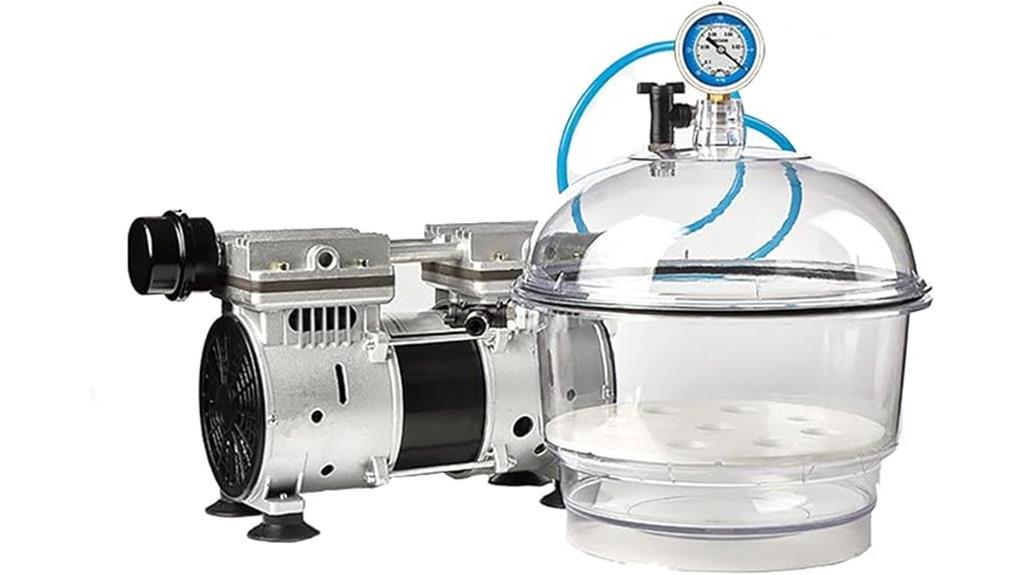
The Generic Vacuum Desiccators, Small Laboratory Transparent Plastic Desiccator stands out as an ideal choice for researchers and technicians who need reliable, durable, and easy-to-monitor vacuum drying solutions. Made from high-strength polycarbonate, it resists heat and oxidation while maintaining clarity for visual inspection. The silicone rubber seals eliminate the need for grease, ensuring airtightness and long-lasting performance. With a vacuum gauge and dual needle valve, you can precisely control internal pressure. Its frost-covered lid prevents slipping, and the vacuum can be maintained for up to 100 days, making it perfect for drying and long-term storage of sensitive laboratory items.
Best For: researchers and technicians seeking reliable, durable, and easy-to-monitor vacuum drying and storage solutions for sensitive laboratory items.
Pros:
- Made from high-strength polycarbonate, offering excellent heat and oxidation resistance.
- Features a transparent design for easy visual inspection without opening the desiccator.
- Equipped with a vacuum gauge and dual needle valve for precise internal pressure control.
Cons:
- Relatively heavy at 13.2 pounds, which may affect portability.
- Limited to vacuum durations of up to 100 days, which may not be sufficient for some long-term applications.
- No mention of additional accessories or customizable options for specific laboratory needs.
Factors to Consider When Choosing Vacuum Desiccators
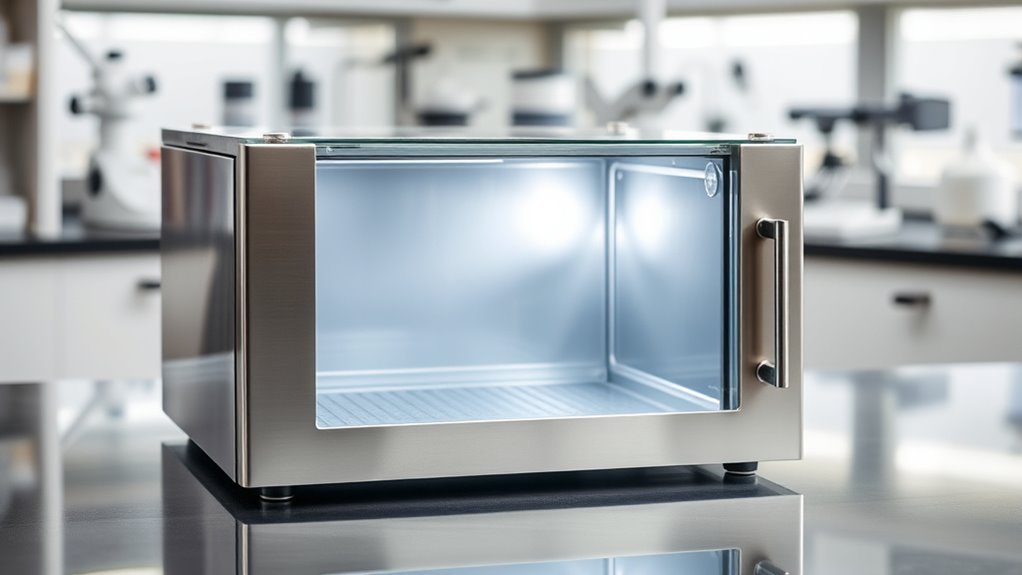
When selecting a vacuum desiccator, I consider several key factors to guarantee it meets my needs. The quality of the vacuum seal, material compatibility, and size are vital for reliable performance. Additionally, I look at how easy it is to maintain the seal and whether it works well with my accessories.
Vacuum Seal Quality
A high-quality vacuum seal is essential for maintaining the desired vacuum level in a desiccator over time. It minimizes leakage, allowing the vacuum to last for 72 hours or more, which is crucial for consistent moisture control. The material and design of the O-ring, like silicone rubber, play a vital role in ensuring airtight integrity. A precise fit between the lid and chamber, often with ground glass rims or gasket systems, enhances sealing performance. The seal must also resist chemicals, temperature fluctuations, and mechanical wear to ensure long-term reliability. Regular inspection and timely replacement of degraded seals are necessary to prevent vacuum loss. Investing in a desiccator with a robust, well-designed seal guarantees consistent moisture protection and optimal performance.
Material Compatibility
Selecting a vacuum desiccator requires careful attention to material compatibility to guarantee long-term durability and chemical resistance. I always check that the materials used can withstand the chemicals stored inside, preventing corrosion or degradation over time. For most lab needs, borosilicate glass, high-strength polycarbonate, or polypropylene are excellent choices because they resist common reagents and reagents. It’s also important to verify that sealing components, like O-rings, are made from compatible elastomers such as silicone rubber or PTFE to avoid leaks and chemical reactions. Additionally, consider the temperature resistance of the materials, especially if autoclaving or heating is involved. Matching the material’s durability with your storage environment ensures the desiccator maintains airtight integrity and protects your samples long-term.
Capacity and Size
Choosing the right capacity and size for your vacuum desiccator is essential to meet your laboratory needs. You should select a desiccator that matches your sample volume to make sure enough space for desiccants and samples. Pay attention to internal dimensions—height and diameter—to accommodate larger items or multiple samples at once. It’s also important to take into account your available workspace and storage area; a larger desiccator might offer more interior volume but could be impractical if space is limited. Keep in mind that bigger models may require more maintenance and desiccant material, which can impact costs. Ultimately, matching the size to your specific drying and storage requirements helps optimize efficiency and keeps your lab running smoothly.
Seal Maintenance Ease
When considering the overall functionality of a vacuum desiccator, ease of seal maintenance plays a significant role. A dependable desiccator should have a high-quality O-ring that stays airtight without frequent re-greasing or adjustments. Silicone rubber O-rings are effective and resistant to chemicals, but they may need replacing over time to maintain seal integrity. Desiccators with standardized, compatible seals make routine upkeep simpler and reduce leak risks. Designs that allow quick removal and easy cleaning or gasket replacement further improve maintenance. Additionally, smooth, flat sealing surfaces ensure proper contact, minimizing debris and facilitating easier upkeep. Overall, selecting a desiccator with straightforward seal maintenance helps ensure consistent airtightness and reliable moisture control, saving you time and preventing potential issues in your lab.
Compatibility With Accessories
Ensuring your vacuum desiccator can accommodate the accessories you need is vital for ideal performance. I check that its design supports items like perforated plates, support stands, or specialized inserts without hindrance. Compatibility with stopcocks, valves, and connection ports is essential; they should fit your tubing or fittings perfectly to prevent leaks and maintain airtight seals. I also verify that the lid or cover can securely hold accessories such as desiccant trays and shelves, guaranteeing vacuum integrity isn’t compromised. Additionally, I consider whether the materials of the accessories, like PTFE or polypropylene, match the desiccator’s construction for durability and chemical resistance. Finally, I confirm the internal dimensions and configuration support your specific needs, whether that’s larger support plates or custom inserts for specialized applications.
Vacuum Duration
Vacuum duration is a key factor to contemplate because it determines how long your desiccator can maintain a stable environment without re-evacuating. This is especially important for long-term sample preservation or drying processes. Desiccators built for extended vacuum retention can hold a vacuum for 24 hours or more, ensuring consistent conditions during experiments. Factors such as the quality of the seal, materials used, and design features greatly influence this duration. High-quality seals like silicone rubber or O-rings help achieve longer vacuum retention. Some models can maintain a vacuum for up to 100 days, which is ideal for moisture-sensitive storage. Regularly monitoring vacuum levels with integrated gauges helps you assess performance and know when re-evacuation is necessary, ensuring your samples stay protected.
Ease of Observation
Have you ever struggled to check your samples without opening the desiccator? Clear construction is essential for easy observation. Transparent lids and bases made of borosilicate glass or polycarbonate allow me to see inside instantly, saving time and preventing contamination. Desiccators with large, ribbed knobs and wide openings make handling straightforward, especially when I need to inspect or adjust contents quickly. Recessed or perforated plates designed with visibility in mind help me assess moisture levels and the effectiveness of the desiccant at a glance. Using colorless, see-through materials guarantees there are no obstructions, so I can monitor internal processes or sample dryness efficiently. Overall, a well-designed vacuum desiccator with excellent visibility simplifies maintenance and enhances my workflow.
Frequently Asked Questions
What Is the Maximum Vacuum Pressure Each Desiccator Can Achieve?
The maximum vacuum pressure each desiccator can achieve varies, but most can reach around 29.9 inches of mercury (Hg), or roughly 101 kPa. Some high-quality models may go slightly lower, approaching 29.5 inches Hg. I always check the specifications before purchasing to guarantee they meet my lab’s needs. Achieving a deep vacuum helps keep moisture out, maintaining sample integrity and ensuring precise, reliable results.
How Easy Is It to Clean and Sterilize These Vacuum Desiccators?
Back in the day, cleaning a vacuum desiccator was a breeze – and it still is. I find that removing the lid and wiping down the interior with a damp cloth or mild detergent keeps it spotless. For sterilization, I typically use alcohol wipes or sterilize with ethylene oxide if needed. It’s straightforward, and regular maintenance makes certain your desiccator stays in top shape for reliable moisture control.
Are Replacement Parts or Accessories Readily Available?
Yes, replacement parts and accessories are generally easy to find. I usually get them directly from the manufacturer or authorized distributors, which guarantees compatibility and quality. Many suppliers keep a stock of common parts like seals, vacuum gauges, and shelves, so I rarely face delays. Having quick access to these components helps me maintain my vacuum desiccators efficiently and assures they stay in top condition for precise moisture control.
What Are the Safety Features Included in These Vacuum Desiccators?
Think of these desiccators as guardians of your delicate samples. They include safety features like pressure release valves to prevent over-pressurization, sturdy latches ensuring secure sealing, and durable materials that resist breakage. Some also have built-in alarms or indicators to alert you to issues. These features work together like vigilant sentinels, keeping your lab safe while maintaining the perfect environment for your moisture-sensitive items.
How Do Temperature Fluctuations Affect Their Moisture Control Performance?
Temperature fluctuations can substantially impact moisture control in vacuum desiccators. When temperatures rise, moisture inside can evaporate, increasing humidity levels and compromising sample integrity. Conversely, colder temperatures may cause condensation, leading to potential damage or contamination. I always monitor lab temperatures closely and avoid sudden changes to guarantee consistent performance. Proper insulation and stable environmental conditions help maintain ideal moisture levels, keeping my samples dry and reliable.
Conclusion
Just like Sherlock Holmes meticulously searches for clues, selecting the right vacuum desiccator guarantees your lab’s moisture control is spot-on. Whether you need a compact polycarbonate model or a heavy-duty backpack vacuum, the options I’ve shared will help you make an informed decision. Remember, the right desiccator isn’t just equipment—it’s your secret weapon against humidity’s sneaky interference, keeping your experiments precise and reliable every time.



